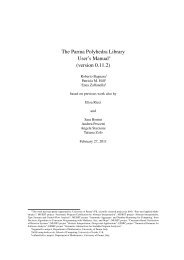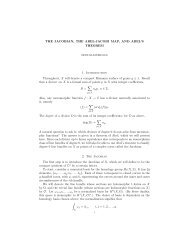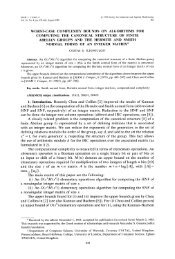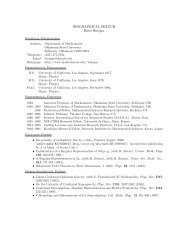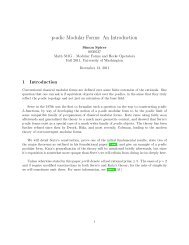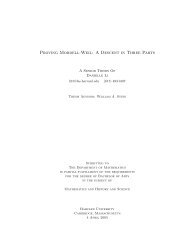Introductory Differential Equations using Sage - William Stein
Introductory Differential Equations using Sage - William Stein
Introductory Differential Equations using Sage - William Stein
You also want an ePaper? Increase the reach of your titles
YUMPU automatically turns print PDFs into web optimized ePapers that Google loves.
1.2. INITIAL VALUE PROBLEMS 11<br />
<strong>using</strong> <strong>Sage</strong>.<br />
x ′ + x = 1, x(0) = 3,<br />
5. Write a differential equation for a population P that is changing in time (t) such that<br />
the rate of change is proportional to the square root of P.<br />
1.2 Initial value problems<br />
Recall, 1 st order initial value problem, or IVP, is simply a 1 st order ODE and an initial<br />
condition. For example,<br />
x ′ (t) + p(t)x(t) = q(t), x(0) = x 0 ,<br />
where p(t), q(t) and x 0 are given. The analog of this for 2 nd order linear DEs is this:<br />
a(t)x ′′ (t) + b(t)x ′ (t) + c(t)x(t) = f(t), x(0) = x 0 , x ′ (0) = v 0 ,<br />
where a(t), b(t), c(t), x 0 , and v 0 are given. This 2 nd order linear DE and initial conditions<br />
is an example of a 2 nd order IVP. In general, in an IVP, the number of initial conditions<br />
must match the order of the DE.<br />
Example 1.2.1. Consider the 2 nd order DE<br />
x ′′ + x = 0.<br />
(We shall run across this DE many times later. As we will see, it represents the displacement<br />
of an undamped spring with a unit mass attached. The term harmonic oscillator is<br />
attached to this situation [O-ivp].) Suppose we know that the general solution to this DE<br />
is<br />
x(t) = c 1 cos(t) + c 2 sin(t),<br />
for any constants c 1 , c 2 . This means every solution to the DE must be of this form. (If<br />
you don’t believe this, you can at least check it it is a solution by computing x ′′ (t) + x(t)<br />
and verifying that the terms cancel, as in the following <strong>Sage</strong> example. Later, we see how to<br />
derive this solution.) Note that there are two degrees of freedom (the constants c 1 and c 2 ),<br />
matching the order of the DE.<br />
<strong>Sage</strong><br />
sage: t = var(’t’)<br />
sage: c1 = var(’c1’)<br />
sage: c2 = var(’c2’)<br />
sage: de = lambda x: diff(x,t,t) + x<br />
sage: de(c1*cos(t) + c2*sin(t))<br />
0<br />
sage: x = function(’x’, t)



